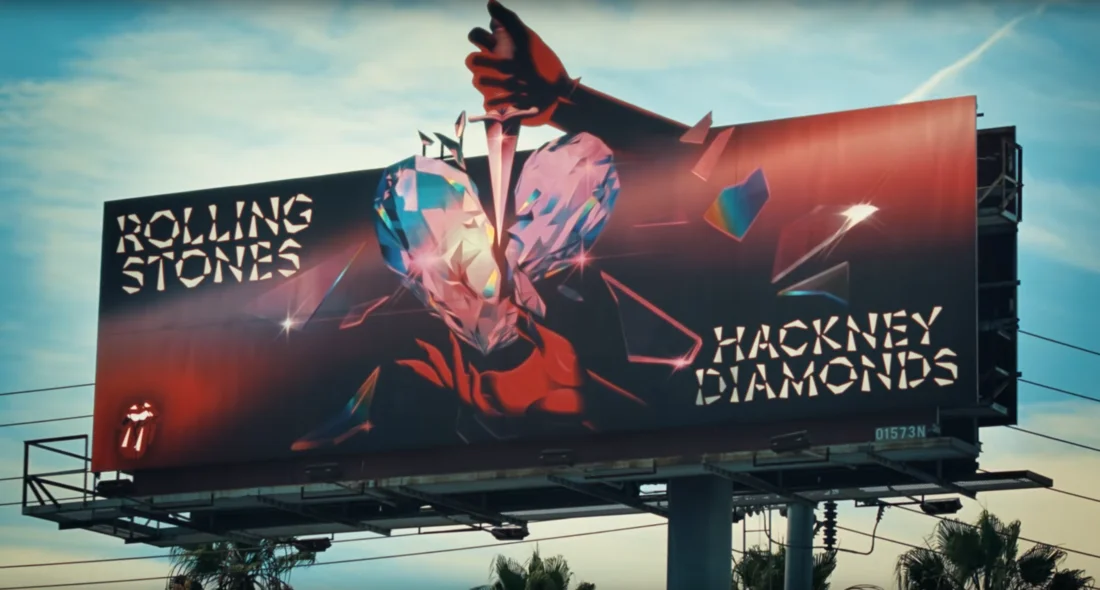
The Rolling Stones revolutionize Sunset Boulevard by going full DOOH

The Rolling Stones’ latest music video “Angry” utilizes digital billboards to build a cinematic journey across Sunset Boulevard, portraying the lasting bond between OOH and pop culture, and showcasing the remarkable potential of out-of-home displays.
Out-of-home advertising has been at the core of pop culture ever since the first billboard posters of popular rock bands hit the streets back in the 60’s, in a time when music videos were still to come, and the digital world was almost unthinkable.
Though decades have passed, OOH advertising not only has prevailed among pop culture, but it has also evolved and transformed itself as the digital world emerged and programmatic technologies became available to change the game. Nowadays, Digital-Out-of-Home advertising is making waves in the industry – and just recently, a groundbreaking artistic project has come to shine light into the revolutionary qualities of DOOH displays.
“Angry”, the new single by The Rolling Stones, reflects on those liaisons that stand the test of time with a creative twist in the use and meaning of classic billboards, which nevertheless resemble the ways in which brand marketing campaigns can now be executed thanks to Digital Out-of-Home (DOOH) technologies.
The music video, directed by Francois Rousselet and starred by young actress Sydney Sweeney, is a true ode to culture icons: a rebel couple drives through the lively streets of Sunset Strip, singing along as they pass by an endless number of digital, 3D and cinematic billboards of all sizes, colors and forms that showcase the band performing the song.
Timeless Success: Analyzing the Prevalence of OOH Advertising
Artists and billboards have always been representative elements of pop culture, feeding one another to perpetuate themselves; in some way, several rock and pop music artists transcended and became well-known thanks to billboards and other OOH displays that portrayed them for the world to remember.
In “Angry”, we see both current and older versions of The Rolling Stones through digital animated billboards, in an intentional merge of the old and the new; Rousselet created those billboards himself along with motion graphics designers, utilizing archive footage from live gigs, old videos and album iconography.
This, along with the performance of contemporary icon Sydney Sweeney, on top of a vintage convertible Mercedes Benz, depicts the timeless nature of pop culture and its elements.
Just as ageless rock bands like The Rolling Stones, OOH has also made essential contributions to society as a classic form of advertising that, up to this date, has an enormous visual impact and the potential to reach the public consciousness in a way that no other channel has.
With the ability to capture attention with just one look, billboards are unlikely to go missing, and the digital realm revamps them as immersive, interactive screens that can engage viewers completely, as we can experience in the music video – it would be hard to take the eyes off Mick Jagger’s performance if we came across a vibrant digital billboard like the ones in “Angry”. That is precisely the intention of DOOH advertising.
Branding Gone Well: The Marketing Campaign Behind “Angry”
The promotion of The Rolling Stones’ new single was rolled out as an advertising strategy that marketers should definitely be mindful about. The video was not only promoted through the band’s social media, but also through Sweeney’s allusive Instagram updates, which built expectations and extended the campaign’s reach among younger viewers.
This partnership between DOOH and social media, which we analyzed in other articles, constitutes an organic part of any modern marketing campaign that aims to be stuck in people’s minds, as it takes the brand’s presence both offline and online, fostering consumer engagement and creating a sense of community.
In addition, and thanks to the preceding promotion, the music video hit a great number of views within the first few hours after its release. This adds an extra layer to the capacity of digital advertising campaigns to reach diverse audiences, another proof of the superb potential DOOH advertising holds as a marketing tool that extends beyond the streets and into the lives of the audience.
If you haven’t seen it yet, watch the music video of “Angry” by The Rolling Stones and witness the transformative power of DOOH displays!
